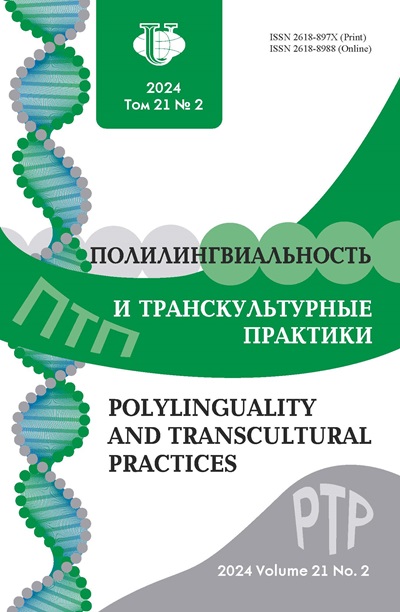Мотив как трансисторический феномен в повести адыгско-русского билингва-просветителя XIX в. Хан-Гирея «Черкесские предания»
- Авторы: Казиева Э.М.1, Плисс А.А.1
-
Учреждения:
- Пятигорский государственный университет
- Выпуск: Том 16, № 2 (2019)
- Страницы: 276-288
- Раздел: Художественное измерение
- URL: https://journals.rudn.ru/polylinguality/article/view/21334
- DOI: https://doi.org/10.22363/2618-897X-2019-16-2-276-288
Цитировать
Полный текст
Аннотация
В статье рассматриваются вопросы изучения мотивной структуры «кавказского текста» в произведениях северо-кавказской литературы первой половины XIX в. В период национального подъема, связанного с декабристским движением, литература пополнилась рядом произведений о Кавказе, написанных Султаном Хан-Гиреем, Султаном Казы-Гиреем, Адиль-Гиреем Кешевым, Костой Хетагуровым и др. Сложилась целая литературная традиция, которая не только поэтизировала кавказский мир, но и старалась изучать его этнографически. Актуальность статьи связана и с тем обстоятельством, что кавказские мотивы легко прочитываются как в творениях пишущих на русском языке авторов, для которых этот регион является исторической отчизной, так и русских писателей, тяготеющих в собственных художественных пристрастиях к самым разным течениям и стилистическим принципам - от романтических до постмодернистских. Для некоторых из них интерес к мотивам Кавказа является определяющим для всего творчества. Авторы впервые предприняли попытку рассмотреть мотивы, характерные для произведений русской и северо-кавказской литератур о Кавказе в контексте диалога культур.
Об авторах
Эльмира Магомедовна Казиева
Пятигорский государственный университет
Автор, ответственный за переписку.
Email: k_mika@mail.ru
доктор филологических наук, профессор кафедры словесности и педагогических технологий филологического образования Пятигорского государственного университета
Российская Федерация, 357532, Ставропольский край, Пятигорск, пр. Калинина, 9Анна Александровна Плисс
Пятигорский государственный университет
Email: k_mika@mail.ru
аспирант кафедры отечественной и зарубежной литературы Пятигорского государственного университета
Российская Федерация, 357532, Ставропольский край, Пятигорск, пр. Калинина, 9Список литературы
- Gasparov, M.L. 2000. O russkoj poezii. Analizy. Harakteristiki [About Russian Poetry]. St. Petersburg. Print. (In Russ.)
- Shul’zhenko, V.I. 2001. Kavkazskij fenomen russkoj prozy (vtoraya polovina XX veka) [Caucasian phenomenon of Russian Prose (second half of the 20th century)]. Pyatigorsk: PyatGFA. Print. (In Russ.).
- Halizev, V.E. 2000. Teoriya literatury [Theory of Literature]. Moscow: Vysshaya shkola. Print. (In Russ.).
- Lotman, Yu.M. 2002. Stat’i, po semiotike iskusstva (Seriya «Mir iskusstva») [Articles on Art Semiotics]. St. Petersburg. Print. (In Russ.).
- Zemskov, V.N. 1993. “Latinoamerikanskaya literatura kak model’ kul’tury” [Latin American Literature as a Model of Culture]. Latin America 9: 64-65. Print. (In Russ.).
- Shchukin, V. 1999. “Moskva i «moskovskij tekst» russkoj kul’tury” [Moscow and Moscow Text of Russian Culture]. Novoe literaturnoe obozrenie 39: 412. Print. (In Russ.).
- Kofman, A.F. 1997. Latinoamerikanskij hudozhestvennyj obraz mira [Latin American Image of the World]. Moscow. Print. (In Russ.).
- Kristeva, Yu. 2004. Izbrannye trudy: Razrushenie poetiki [Selected Worcs. Distruction of Poetics]. Rosspen. Print. (In Russ.).
- Andreev-Krivich, S.A. 1979. Kabardino-cherkesskij fol’klor v tvorchestve Lermontova [KabardinoCircassian Folklore in the Works by Lermontov]. Nal’chik. Print. (In Russ.)
- Averincev, S.S. 1997. Poetika rannevizantijskoj literatury [Poetics of the Early Byzantine Literature]. Moscow. Print. (In Russ.)
- Alieva, A.I. 1969. Adygskij nartskij epos [Adyg Narts Epic]. Moscow, Nal’chik. Print. (In Russ.)















